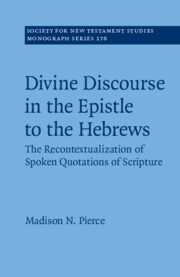 Divine Discourse in the Epistle to the Hebrews
Divine Discourse in the Epistle to the Hebrews Book contents
- Divine Discourse in the Epistle to the Hebrews
- Society for New Testament Studies
- Divine Discourse in the Epistle to the Hebrews
- Copyright page
- Dedication
- Contents
- Acknowledgments
- 1 The Author’s Exegetical Method and Speech in Hebrews
- 2 Intra-Divine Discourse (1)
- 3 Intra-Divine Discourse (2)
- 4 Extra-Divine Discourse
- 5 Divine Discourse and the Structure of Hebrews
- 6 Conclusion
- Bibliography
- Scripture and Primary Source Index
- Secondary Source Index
- Subject Index
2 - Intra-Divine Discourse (1)
The Father Addresses the Son
Published online by Cambridge University Press: 14 August 2020
- Divine Discourse in the Epistle to the Hebrews
- Society for New Testament Studies
- Divine Discourse in the Epistle to the Hebrews
- Copyright page
- Dedication
- Contents
- Acknowledgments
- 1 The Author’s Exegetical Method and Speech in Hebrews
- 2 Intra-Divine Discourse (1)
- 3 Intra-Divine Discourse (2)
- 4 Extra-Divine Discourse
- 5 Divine Discourse and the Structure of Hebrews
- 6 Conclusion
- Bibliography
- Scripture and Primary Source Index
- Secondary Source Index
- Subject Index
Summary
This chapter examines passages in Hebrews where the Father or God is portrayed as the speaker of Scripture quotations (Heb 1:5–13; 5:1–10; 7:1–28; 8:1–13). In Hebrews 1, the Father speaks 7 quotations to the Son or to/about the angels. These quotations show the Son’s superiority. In Hebrews 5, the quotations show how the Son is called to be a priest and how that is linked to his Sonship. In Hebrews 7, the author’s important quotation of Ps 110:4 establishes Jesus as a high priest in the likeness of Melchizedek. Finally, in Hebrews 8, the Father speaks and establishes a “new covenant.” In most instances, a pattern emerges where the Father speaks to the Son and confers authority upon him. These speeches are then “overheard” by the addressees.
- Type
- Chapter
- Information
- Divine Discourse in the Epistle to the HebrewsThe Recontextualization of Spoken Quotations of Scripture, pp. 35 - 90Publisher: Cambridge University PressPrint publication year: 2020
